Independent Living emphasizes the empowerment of individuals with disabilities to take control of their lives to the maximum extent possible. The person isn’t a patient, but a consumer that controls the services that are consumed. The problem isn’t with the individual, but the environmental barriers to independent living. The solution is to remove barriers through advocacy and self-help. This concept has slowly gained strength since the 1960’s. This concept also rejects the medical and rehabilitation models, which have been common since World War II.
Section 504 of the 1973 Rehabilitation Act was the first disability civil rights law to be enacted in the United States. It prohibits discrimination against people with disabilities in programs that receive federal financial assistance and set the stage for enactment of the Americans with Disabilities Act. Section 504 works together with the ADA and IDEA to protect children and adults with disabilities from exclusion, and unequal treatment in schools, jobs and the community.
A sit-in and demonstrations in San Francisco and Washington DC, in 1977, changed the course of civil rights history, and resulted in the signing of the 1977 Health, Education, and Welfare (HEW) regulations implementing Section 504 of the Rehabilitation Act of 1973.
https://www.youtube.com/watch?v=cgviLQyLjrs&feature=youtu.be
SOURCE: – The Disability Rights Education and Defense Fund (DREDF) – https://dredf.org
Section 508 of the Rehabilitation Act (29 U.S.C. § 794d), as amended by the Workforce Investment Act of 1998 (P.L. 105-220) requires federal agencies to develop, procure, maintain and use information and communications technology (ICT) that is accessible to people with disabilities – regardless of whether or not they work for the federal government. The US Access Board established the Section 508 standards that implement the law and provides the requirements for accessibility.
Section 508 requires federal agencies to make their ICT such as technology, online training and websites accessible for everyone. This means that federal employees with disabilities are able to do their work on the accessible computers, phones and equipment in their offices, take online training or access the agency’s internal website to locate needed information. Section 508 also means that a person with a disability applying for a job with the federal government or a person who is using an agency’s website to get information about a program, or completing an online form has access to the same accessible information and resources available to anyone.
Information and Communications Technology (ICT) is any equipment or system that is used to create, convert, duplicate or access information and data. Examples of ICT include, but are not limited to:
- Telephones, smart phones and mobile devices
- Televisions, DVD players and videotaped productions
- Internet and Intranet websites
- PDF documents
- Content on DVDs and CDs
- Online training
- Webinars and teleconferencing
- Technical support call centers
- Remote access websites and tools
- Tablet, laptop and desktop computers
- Software and operating systems
- User guides for software and tools
- Copiers, printers and fax machines
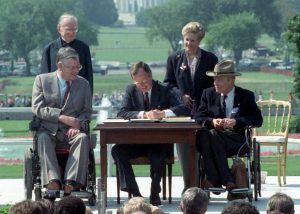 |
The Americans with Disabilities Act (ADA) became law in 1990. The ADA is a civil rights law that prohibits discrimination against individuals with disabilities in all areas of public life, including jobs, schools, transportation, and all public and private places that are open to the general public. The purpose of the law Is to make sure that people with disabilities have the same rights and opportunities as everyone else. The ADA is divided into five titles {or sections) that relate to different areas of public life. |
Title I – Employment
- Helps people with disabilities access the same employment opportunities and benefits available to people without disabilities.
- Applies to employers with 15 or more employees
- Requires employers to provide reasonable accommodations to qualified applicants or A “reasonable accommodation” is a change that accommodates employees with disabilities so they can do the job without causing the employer “undue hardship” {too much difficulty or expense).
- Defines disability, establishes guidelines for the reasonable accommodation process, and addresses medical examinations and
- Regulated and enforced by the S. Equal Employment Opportunity Commission https://www.eeoc.gov/laws/types/disability.cfm (link is external)
Title II – Public Services: State and Local Government
- Prohibits discrimination on the basis of disability by “public entities” such as state and local government
- Requires public entities to make their programs, services and activities accessible to individuals with
- Outlines requirements for self-evaluation and planning; making reasonable modifications to policies, practices, and procedures where necessary to avoid discrimination; identifying architectural barriers; and communicating effectively with people with hearing, vision and speech disabilities.
- Regulated and enforced by the U.S. Department of Justice. http://www.ada.gov
Title III – Public Accommodations and Services Operated by Private Entities
- Prohibits places of public accommodation from discriminating against individuals with Public accommodations include privately owned, leased or operated facilities like hotels, restaurants, retail merchants, doctor’s offices, golf courses, private schools, day care centers, health clubs, sports stadiums, movie theaters, and so on.
- Sets the minimum standards for accessibility for alterations and new construction of commercial facilities and privately owned public accommodations. It also requires public accommodations to remove barriers in existing buildings where it is easy to do so without much difficulty or
- Directs businesses to make “reasonable modifications” to their usual ways of doing things when serving people with
- Requires that businesses take steps necessary to communicate effectively with customers with vision, hearing, and speech
- Regulated and enforced by the S. Department of Justice. https://www.ada.gov (link is external)
Title IV – Telecommunications
- Requires telephone and Internet companies to provide a nationwide system of interstate and intrastate telecommunications relay services that allows individuals with hearing or speech disabilities to communicate over the
- Requires closed captioning of federally funded public service announcements.
- Regulated by the Federal Communication https://www.fcc.gov (link is external)
Title V- Miscellaneous Provisions
- Contains a variety of provisions relating to the ADA as a whole, including its relationship to other laws, state immunity, its impact on insurance providers and benefits, prohibition against retaliation and coercion, illegal use of drugs, and attorney’s
- Provides a list of certain conditions that are not considered
Transportation
- Public Transportation offered by a state or local government is covered by Title II of the Publicly funded transportation includes, but is not limited to, bus and passenger train (rail) service. Rail service includes subways (rapid rail), light rail, commuter rail, and Amtrak.
- If transportation is offered by a private company, it is covered by Title III. Privately funded transportation includes, but is not limited to, taxicabs, airport shuttles, intercity bus companies, such as Greyhound, and hotel-provided transportation.
- The S. Department of Transportation, Federal Transit Administration releases information, guidance and regulations on transportation and the ADA.
SOURCE: ADA National Network – https://adata.org
|
Olmstead, or Olmstead v. LC, is the name of the most important civil rights decision for people with disabilities in our country’s history. This 1999 United States Supreme Court decision was based on the Americans with Disabilities Act. The Supreme Court held that people with disabilities have a qualified right to receive state funded supports and services in the community rather than institutions when the following three-part test is met:
|
 |
Brief History of Olmstead
The Olmstead lawsuit started with two women from Georgia named Lois Curtis and Elaine Wilson who both had diagnoses of mental health conditions and intellectual disabilities. Lois and Elaine found themselves going in and out of the state’s mental health hospitals dozens of times. After each stay in the hospital, they would go back home; but then, because they did not have help at home, they would start to struggle again and would have to go back to the hospital to get help again. Lois and Elaine asked the state of Georgia to help them get treatment in the community so that they would not have to go live at the state mental hospital off and on. The doctors who treated Lois and Elaine agreed that they were capable of living in the community with appropriate supports. However, Lois and Elaine ended up waiting for years for their community-based supports to be set up.
Sue Jamieson, who was an attorney at the Atlanta Legal Aid Society, filed a lawsuit on behalf of Lois (and then later added Elaine) for supports to be provided in the community. The lawsuit, which is known as “Olmstead v. LC.” or “the Olmstead decision,” ended up going to the highest court in the country, the United States Supreme Court. The name Olmstead comes from the name of the Defendant In the case, Tommy Olmstead, who was the Commissioner of the Georgia Department of Human Resources.
The Supreme Court agreed with Lois and Elaine. The Court found that under the Americans with Disabilities Act, or “the ADA,” it is against the law for the state to discriminate against a person based on his or her disability. The Court said that the state discriminated against Lois and Elaine by requiring them to live in a mental health hospital. It should have instead provided services for them in the community. By confining them in the hospital, the state was segregating them by requiring them to live with others with disabilities. The Court said that people with disabilities like Lois and Elaine have the right to receive the treatment they needed in an integrated setting if that is what they want, if their doctors agree, and if it doesn’t fundamentally change how the state provides services to people with disabilities.
SOURCE: Olmstead Rights – https://www.olmsteadrights.org
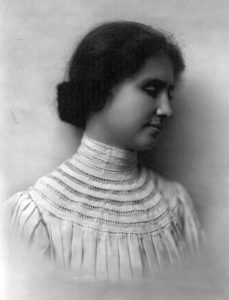 |
Helen Keller was an American educator, advocate for the blind and deaf and co-founder of the ACLU. Stricken by an illness at the age of 2, Keller was left blind and deaf. Beginning in 1887, Keller’s teacher, Anne Sullivan, helped her make tremendous progress with her ability to communicate, and Keller went on to college, graduating in 1904. During her lifetime, she received many honors in recognition of her accomplishments.
Throughout the first half of the 20th century, Keller tackled social and political issues, including women’s suffrage, pacifism, birth control and socialism. After college, Keller set out to learn more about the world and how she could help improve the lives of others. When the American Federation for the Blind was established in 1921, Keller had an effective national outlet for her efforts. She became a member in 1924, and participated in many campaigns to raise awareness, money and support for the blind, working for the American Foundation for the Blind for more than 40 years.
https://www.youtube.com/watch?v=aTJv0DoIgY8
SOURCE: American Federation of the Blind – https://www.afb.org
Biography.com – https://www.biography.com/activist/helen-keller
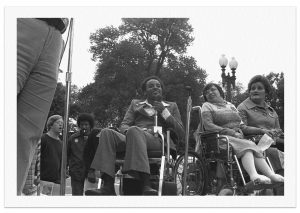 |
In the 1970’s Bradley Lomax was an Oakland resident and member of the Black Panther Party (BPP). He also had Multiple Sclerosis and used a wheelchair. In 1974, Lomax was working at the Panthers’ George Jackson Clinic, which provided free community medical care as part of the BPP “serve the people” programs. Recognizing the need for more disability services and supports in his own community, in 1975, Lomax approached Ed Roberts (who had helped found the Center for Independent Living in Berkeley in 1972), with a proposal to open a Center for Independent Living (CIL) in East Oakland under Black Panther sponsorship. Less than a year later, with Lomax as one of a two-person staff, the East Oakland CIL opened in a storefront, offering basic peer counseling and attendant referral. |
The BPP had no particular disability policy, but with Lomax’s active participation in disability advocacy, they began supporting other initiatives, most notably the historic 504 sit-ins to force the government to implement Section 504 of the Rehabilitation Act.
Bradley Lomax was an active participant in the sit-in, a sacrifice which much affected his disability later in life, and afterwards was a member the contingent that took the disability message to Washington DC.
SOURCE: Lead On Network
|
Laura Hershey was born with a form of muscular dystrophy and lived in a wheelchair and was one of the most prominent voices of the disability rights movement. Hershey was perhaps best known for protesting Jerry Lewis’s muscular dystrophy telethons. Once a poster child for those campaigns, Hershey grew to believe the telethons create the impression that people with muscular dystrophy have lives that are not worth living. She was cited for trespassing in 2001 during a protest outside the telethon’s local telecast. “Other organizations,” she said at the time, “have found ways to fund-raise without demeaning the people they are trying to serve.” But her family said her activism was much deeper than the protests. She twice attended United Nations conferences on women’s rights, one in Nairobi, Kenya, and another in Beijing, her brother, John Hershey, said. She was a tireless advocate for not only the disabled, but also the disadvantaged and anyone who didn’t “fit in,” John Hershey said. |
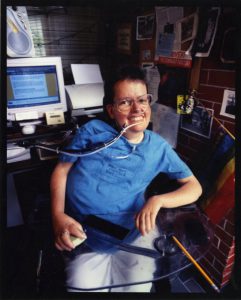 |
Her writings were an inspiration to many, John Hershey said, and she has a book of poems called Spark Before Dark that she finished shortly before her death that is scheduled to be published by Finishing Line Press.
Hershey received an honorary doctorate for her work from Colorado College, where she also earned her undergraduate degree. By Saturday night, her Facebook page was flooded with messages of remembrance and appreciation.
Hershey’s last essay, a blog post for the Christopher and Dana Reeve Foundation finished two days before she died, focuses on gratitude. In it, she talks about a recent trip to California and about taking joy in life’s purest moments. She writes of the joy of watching her daughter’s pure delight at dancing in the ocean for the first time ever.”
But, in a passage that exemplifies her work, she also cautions the disabled against being forced to feel grateful for necessities.
“We have to demand the things that are essential to our lives, equality, and quality of life,” she wrote. “We must refuse to feel gratitude for these, except the normal level of gratitude that anyone might feel for living in a time and place that still supports human life.”
SOURCE: The Denver Post, John Ingold –
https://www.denverpost.com/2010/11/27/laura-hershey-48-championed-disabilityrights
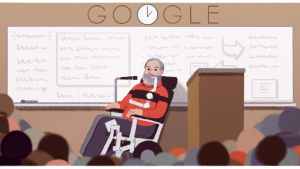 |
Ed Roberts is considered to be the founder of the independent living movement. A leader and activist, Roberts was a promoter of self-advocacy, independent living, educational access, and the right of people with disabilities to make decisions about their own lives.
Roberts was born in 1939 and grew up with a passion for baseball. At the age of 14, he contracted polio and was paralyzed as a result. Ed was told and believed that he would be nothing but a “vegetable,” and eventually tried to die by refusing to eat. After his nurse quit, though, Ed realized he had power to make decisions about his own life and decided that he wanted to live life fully.
Ed began to participate in his high school classes over the phone, and by his senior year, was able to attend the school in person. After two years of community college, he was determined to attend UC Berkeley. It was at Berkeley that Roberts began his political activism and organizing.
Berkeley’s campus was physically inaccessible, so Roberts and many other students with disabilities lived together on a floor in Berkeley’s Cowell Hospital. The group called themselves the “Rolling Quads” and spent their time organizing, discussing their perspectives on life, and experiencing the other collegiate opportunities available to students who did not have disabilities (Shapiro 47). Inspired by the activist culture on campus and the Berkeley Free Speech Movement, Roberts and the Rolling Quads began advocating for more independence.
With the help of an advisor, Roberts created Berkeley’s Disabled Students Program, designed to address the needs of students with disabilities. From there, the Rolling Quads established the Center for Independent Living, an agency for people with disabilities that promoted community-based living and self-advocacy. In 1975, Ed was appointed the director of the California Department of Vocational Rehabilitation by Governor Jerry Brown. In 1984, Roberts was awarded a MacArthur Fellowship, which he and his colleagues Judy Heumann and Joan Leon, used to create the World Institute on Disability.
Roberts’ life was devoted to defying stereotypes and increasing independence. He worked to frame discussions of disability as an issue of civil rights. He died in 1995 at age 56.
https://www.youtube.com/watch?v=ZxidR5SZXxA&feature=youtu.be
SOURCE: Rooted in Rights – https://www.rootedinrights.org/ed-roberts-disability-rights actlvist
|
An Obituary June 22, 2002 By Fred Fay and Fred Pelka, written at Justin Dart’s request. Justin Dart, Jr., was born on August 29, 1930, into a wealthy and prominent family. His grandfather was the founder of the Walgreen Drugstore chain, his father a successful business executive, his mother a matron of the American avant garde. Dart would later describe how he became “a super loser” as a way of establishing his own identity in this family of “super winners.” He attended seven high schools, not graduating from any of them, and broke Humphrey Bogart’s all-time record for the number of demerits earned by a student at elite Andover prep. “People didn’t like me. I didn’t like myself.” Dart contracted polio in 1948. With doctors saying he had less than three days to live, he was admitted into the Seventh Day Adventist Medical University in Los Angeles. “For the first time in my life I was surrounded by people who were openly expressing love for each other, and for me, even though I was hostile to them. And so I started smiling at people and saying nice things to them. And they responded, treating me even better. |
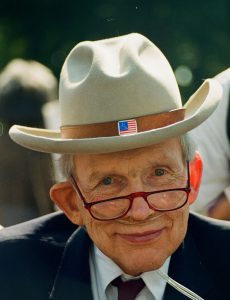 |
It felt so good!” Three days turned into forty years, but Dart never forgot this lesson. Polio left Dart a wheelchair user, but he never grieved about this. “I count the good days in my life from the time I got polio. These beautiful people not only saved my life, they made it worth saving.
Another turning point was Dart’s discovery in 1949 of the philosophy of Mohandas K. Gandhi. Dart defined Gandhi’s message as, 11Find your own truth, and then live it.” This theme too would stay with him for the rest of his life. Dart attended the University of Houston from 1951 to 1954, earning his bachelor’s and master’s degrees in political science and history. He wanted to be a teacher, but the university withheld his teaching certificate because he was a wheelchair user. During his time in college, Dart organized his first human rights group — a pro-integration student group at what was then a whites-only institution.
Dart went into business in 1956, building several successful companies in Mexico and Japan. He started Japan Tupperware with three employees in 1963, and by 1965 it had expanded to some 25,000. Dart used his businesses to provide work for women and people with disabilities. In Japan, for example, he took severely disabled people out of institutions, gave them paying jobs within his company, and organized some of them into Japan’s first wheelchair basketball team. It was during this time he met his wife, Yoshiko.
The final turning point in Dart’s life came during a visit to Vietnam in 1966, to investigate the status of rehabilitation in that war-torn country. Visiting a “rehabilitation center” for children with polio, Dart instead found squalid conditions where disabled children were left on concrete floors to starve. One child, a young girl dying there before him, took his hand and looked into his eyes. ”That scene,” he would later write, “is burned forever in my soul. For the first time in my life I understood the reality of evil, and that I was a part of that reality.”
The Darts returned to Japan but terminated their business interests.
After a period of meditation in a dilapidated farmhouse, the two decided to dedicate themselves entirely to the cause of human and disability rights. They moved to Texas in 1974 and immersed themselves in local disability activism. From 1980 to 1985, Dart was a member, and then chair, of the Texas Governor’s Committee for Persons with Disabilities.
His work in Texas became a pattern for what was to follow: extensive meetings with the grassroots, followed by a call for the radical empowerment of people with disabilities, followed by tireless advocacy until victory was won.
In 1981, President Ronald Reagan appointed Dart to be the vice-chair of the National Council on Disability. The Darts embarked on a nationwide tour, at their own expense, meeting with activists in every state. Dart and others on the Council drafted a national policy that called for national civil rights legislation to end the centuries old discrimination of people with disabilities – what would eventually become the Americans with Disabilities Act of 1990.
In 1986, Dart was appointed to head the Rehabilitation Services Administration, a $3 billion federal agency that oversees a vast array of programs for disabled people. Dart called for radical changes, and for including people with disabilities in every aspect of designing, implementing, and monitoring rehabilitation programs. Resisted by the bureaucracy, Dart dropped a bombshell when he testified at a public hearing before Congress that the RSA was “a vast, inflexible federal system which, like the society it represents, still contains a significant portion of individuals who have not yet overcome obsolete, paternalistic attitudes about disability.” Dart was asked to resign his position but remained a supporter of both Presidents Reagan and Bush. In 1989, Dart was appointed chair of the President’s Committee on the Employment of People with Disabilities, shifting its focus from its traditional stance of urging business to “hire the handicapped” to advocating for full civil rights for people with disabilities.
Dart is best known for his work in passing the Americans with Disabilities Act. In 1988, he was appointed, along with parents’ advocate Elizabeth Boggs, to chair the Congressional Task Force on the Rights and Empowerment of Americans with Disabilities. The Darts again toured the country at their own expense, visiting every state, Puerto Rico, Guam, and the District of Columbia, holding public forums attended by more than 30,000 people. Everywhere he went, Dart touted the ADA as “the civil rights act of the future.” Dart also met extensively with members of Congress and staff, as well as President Bush, Vice President Quayle, and members of the Cabinet. At one point, seeing Dart at a White House reception, President Bush introduced him as “the ADA man.” The ADA was signed into law on July 26, 1990, an anniversary that is celebrated each year by “disability pride” events all across the country.
While taking pride in passage of the ADA, Dart was always quick to list all the others who shared in the struggle: Robert Silverstein and Robert Burgdorf, Patrisha Wright and Tony Coelho, Fred Fay and Judith Heumann, among many others. And Dart never wavered in his commitment to disability solidarity, insisting that all people with disabilities be protected by the law and included in the coalition to pass it — including mentally ill “psychiatric survivors” and people with HIV/AIDS. Dart called this his “politics of inclusion,” a companion to his “politics of principle, solidarity, and love.”
After passage of the ADA, Dart threw his energy into the fight for universal health care, again campaigning across the country, and often speaking from the same podium as President and Mrs. Clinton. With the defeat of universal health care, Dart was among the first to identify the coming backlash against disability rights. He resigned all his positions to become “a full-time citizen soldier in the trenches of justice.” With the conservative Republican victory in Congress in 1994, followed by calls to amend or even repeal the ADA and the individuals with Disabilities Education Act (or IDEA), Dart, and disability rights advocates Becky Ogle and Frederick Fay, founded Justice for All, what Dart called “a SWAT team” to beat back these attacks. Again, Dart was tireless - traveling, speaking, testifying, holding conference calls, presiding over meetings, calling the media on its distortions of the ADA, and flooding the country with American flag stickers that said, “ADA, I DEA, America Wins.” Both laws were saved. Dart again placed the credit with “the thousands of grassroots patriots” who wrote and e-mailed and lobbied. But there can be no doubt that without Dart’s leadership, the outcome might have been entirely different.
In 1996, confronted by a Republican Party calling for “a retreat from Thomas Jefferson, Abraham Lincoln democracy,” Dart campaigned for the re-election of President Clinton. This was a personally difficult “decision of conscience.” Dart had been a Republican for most of his life and had organized the disability constituency campaigns of both Ronald Reagan and George Bush, campaigning against Clinton in 1992. But in a turnabout that was reported in the New York Times and the Washington Post, Dart went all out for Clinton, even speaking at the Democratic National Convention in Chicago. The Darts yet again undertook a whirlwind tour of the country, telling people to “get into politics as if your life depended on it. It does.” At his speech the day after the election, President Clinton publicly thanked Dart for personally campaigning in all fifty states and cited his efforts as “one reason we won some of those states.”
Dart suffered a series of heart attacks in late 1997, which curtailed his ability to travel. He continued, however, to lobby for the rights of people with disabilities, and attended numerous events, rallies, demonstrations and public hearings. Toward the end of his life, Dart was hard at work on a political manifesto that would outline his vision of “the revolution of empowerment.” In its conclusion, he urged his “Beloved colleagues in struggle, listen to the heart of this old soldier. Our lives, our children’s lives, the quality of the lives of billions in future generations hangs in the balance. I cry out to you from the depths of my being. Humanity needs you! Lead! Lead! Lead the revolution of empowerment!”
Today, disabled people across the country and around the world will grieve at the passing of Justin Dart, Jr. But we will celebrate his love and his commitment to justice. Please join us at in expressing our condolences to Yoshiko and her family during this difficult time. Keep in mind, however, that it was Justins wish that any service or commemoration be used by activists to celebrate our movement, and as an opportunity to recommit themselves to “the revolution of empowerment.”
Statement from Justin Dart Dearly Beloved:
Listen to the heart of this old soldier. As with all of us the time comes when body and mind are battered and weary. But I do not go quietly into the night. I do not give up struggling to be a responsible contributor to the sacred continuum of human life. I do not give up struggling to overcome my weakness, to conform my life – and that part of my life called death – to the great values of the human dream.
Death is not a tragedy. It is not an evil from which we must escape. Death is as natural as birth. Like childbirth, death is often a time of fear and pain, but also of profound beauty, of celebration of the mystery and majesty which is life pushing its horizons toward oneness with the truth of mother universe. The days of dying carry a special responsibility. There is a great potential to communicate values in a uniquely powerful way- the person who dies demonstrating for civil rights.
Let my final actions thunder of love, solidarity, protest – of empowerment.
I adamantly protest the richest culture in the history of the world, a culture which has the obvious potential to create a golden age of science and democracy dedicated to maximizing the quality of life of every person, but which still squanders the majority of its human and physical capital on modern versions of primitive symbols of power and prestige.
I adamantly protest the richest culture in the history of the world which still incarcerates millions of humans with and without disabilities in barbaric institutions, backrooms and worse, windowless cells of oppressive perceptions, for the lack of the most elementary empowerment supports.
I call for solidarity among all who love justice, all who love life, to create a revolution that will empower every single human being to govern his or her life, to govern the society and to be fully productive of life quality for self and for all.
I do so love all the patriots of this and every nation who have fought and sacrificed to bring us to the threshold of this beautiful human dream. I do so love America the beautiful and our wild, creative, beautiful people. I do so love you, my beautiful colleagues In the disability and civil rights movement.
My relationship with Yoshiko Dart includes, but also transcends, love as the word is normally defined. She is my wife, my partner, my mentor, my leader and my inspiration to believe that the human dream can live. She is the greatest human being I ever known.
Yoshiko, beloved colleagues, I am the luckiest man in the world to have been associated with you. Thanks to you, I die free. Thanks to you, I die in the joy of struggle. Thanks to you, I die in the beautiful belief that the revolution of empowerment will go on. I love you so much. I’m with you always. Lead on! Lead on!
Justin Dart
SOURCE: Disability Social History Project – https://www.disabilityhistory.org
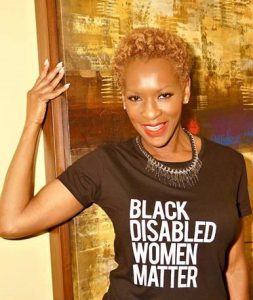 |
Claudia Gordon served as an adviser on disability issues to President Obama, in the White House Office of Public Engagement. She is the first Black Deaf lawyer in the U.S. and the first deaf student to graduate from American University’s law school. She has advocated for deaf and disabled people through work at the National Council on Disability, Homeland Security (where she worked on emergency preparedness for people with disabilities), and the National Coalition for Disability Rights. SOURCE: https://sdaction.org/about/disability-history/ https://obamawhitehouse.archives.gov/blog/2010/08/30/meet-women-administration-claudia-gordon |
| When the ADA stalled in the House Committee on Public Works and Transportation (now the House Committee on Transportation and Infrastructure), people within the disability community became alarmed. About 475 individuals, many in wheelchairs, gathered on the sidewalk in front of the White House to launch the “Wheels of Justice Campaign”. Sixty protesters with disabilities “cast aside their wheelchairs, crutches and walkers to crawl or drag themselves, step by step, up the 78 marble stairs of the Capitol’s West Front. |
 |
This protest, that came to be known as the “Capitol Crawl”, was intended to openly Illustrate the struggles that people in the disabilities communities faced and spurred Congress to pass the ADA. About 1,000 other protesters watched as members of ADAPT (Americans Disabled for Accessible Public Transit, now known only as ADAPT) threw themselves out of their chairs and began their crawl. Together, the march and the crawl comprised one of the largest disability direct actions to date.
The late Michael Winter, former Executive Director of the Berkeley Center for Independent Living, contributed his reflections on the “Capitol Crawl” to ADAPTs 25th Anniversary “I Was There Series” of firsthand accounts:
“Some people may have thought it was undignified for people in wheelchairs to crawl in that manner, but I felt that it was necessary to show the country what kinds of things people with disabilities have to face on a day-to-day basis. We had to be willing to fight for what we believed in.”
SOURCE: The ADA Legacy Project – https://mn.gov/mnddc/ada-legacy/ada-legcay moment27.html
 Official Government Website
Official Government Website
